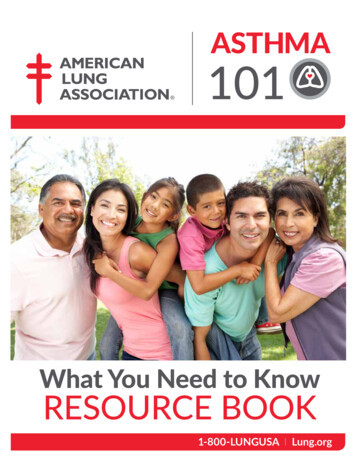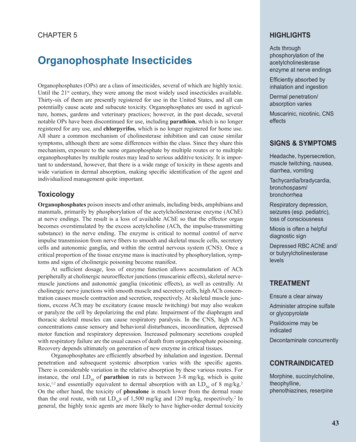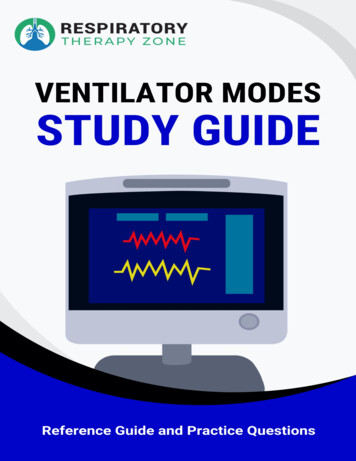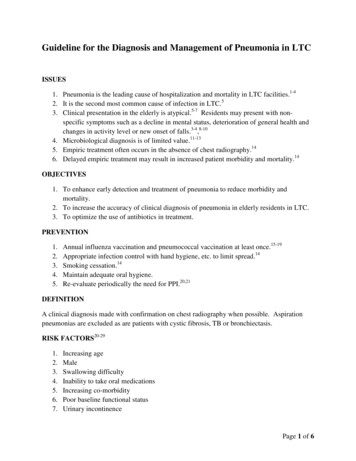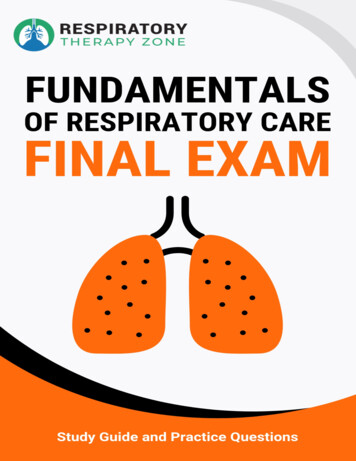
Transcription
Disclaimer:Medicine and respiratory therapy are continuously changingpractices. The author and publisher have reviewed all informationin this report with resources believed to be reliable and accurateand have made every effort to provide information that is up todate with the best practices at the time of publication. Despite ourbest efforts we cannot disregard the possibility of human errorand continual changes in best practices the author, publisher, andany other party involved in the production of this work canwarrant that the information contained herein is complete or fullyaccurate. The author, publisher, and all other parties involved inthis work disclaim all responsibility from any errors containedwithin this work and from the results from the use of thisinformation. Readers are encouraged to check all information inthis book with institutional guidelines, other sources, and up todate information. Respiratory Therapy Zone is not affiliated withthe NBRC, AARC, or any other group at the time of thispublication.You can get access to our massive bank of TMC Practice Questionsby Clicking Here. JCopyright Respiratory Therapy Zone
IntroductionWhy hello there!Thank you so much for downloading this study guide! In this book,you will find a ton of helpful practice questions, all, of course,covering the topic of — Fundamentals of Respiratory Care.These questions are designed to help you prepare for theFundamentals of Respiratory Care final exam in RespiratoryTherapy School.Hopefully, by going through these practice questions, you will beable to boost your knowledge to a whole new level and ace yourfinal exam.This is definitely one of the most important subjects in RespiratoryTherapy School. Not to mention, it’s also the topic that somestudents struggle with.With that being said, (hopefully) this study guide, along with theresources on our website and YouTube channel can help.So if you’re ready, let’s go ahead and get started.Good luck! J
1. While performing postural drainage on a patient who is in ahead-down position, the patient appears dyspneic due to severeprolonged coughing. The respiratory therapist should do whichof the following?A. Perform percussionB. Turn the patientC. Administer oxygenD. Have the patient sit up2. A pediatric patient with an acute upper airway obstructionwould have which of the following physical signs?A. Unilateral lung expansionB. Expiratory wheezingC. Inspiratory stridorD. Inspiratory crackles3. A tachypneic patient with pulmonary edema is brought to theemergency department (ED). Which of the following should beused to provide supplemental oxygen?A. Air entrainment maskB. Nasal cannulaC. Nonrebreathing maskD. Partial rebreathing mask4. While reviewing a patient’s chart, results of a chest radiographindicate complete opacification of the left chest with a shift ofthe trachea and mediastinum to the left. These findings areconsistent with:A. Pneumothorax of the right lungB. Atelectasis of the left lungC. Right sided pleural effusionD. Pulmonary embolus in the left lung5. A physician orders 1 mg atropine by aerosol for a patient. If theconcentration of atropine in a stock solution is 0.04%, howmany mL of the atropine solution must be administered?A. 0.25
B. 0.40C. 0.80D. 2.506. For a tracheal tube cuff to allow circulation to tracheal mucosa,the cuff pressure must be less than:A. Capillary pressureB. Pulmonary artery pressureC. Pulmonary capillary wedge pressureD. Central venous pressure7. Three days postoperatively, a patient is febrile and the whiteblood cell count is 18.000/cu mm. A chest radiograph shows apatchy bilateral infiltrates with air bronchograms. Based on thisinformation, which of the following is the most probablediagnosis?A. PneumoniaB. AtelectasisC. Pulmonary edemaD. Pleural effusion8. Common complications associated with arterial puncturesinclude which of the following?I. Fistula formationII. Hematoma formationIII. Spasm of the vesselA. I onlyB. III onlyC. I and II onlyD. II and III only9. A patient is receiving volume controlled ventilation with acontinuous flow IMV circuit added. The respiratory therapistnotices that the PEEP level drops from the prescribed 8 to 4 cmH2O with each spontaneous breath. To correct this problem,the therapist should increase the:A. PEEP to 12 cm H2O
B. Sensitively settingC. Peak inspiratory flow setting on the ventilatorD. Flow to the continuous flow reservoir bag.10. A 45-year-old patient with mild kyphoscoliosis and postpoliosyndrome requires noninvasive inspiratory assistance and is tobe fitted with a chest cuirass. Which of the following shouldthe respiratory therapist recommend regarding proper fit?I. A 2 to 3 inch air cushion between the shell and the patient’smaximum chest rise is required.II. A cast of the thorax may be made for the patient toaccommodate structural abnormalities.III. A properly fitted cuirass shell should extend anteriorly fromthe clavicle to the bottom of the rib cage.A. I and II onlyB. I and III onlyC. II and III onlyD. I, II and III11. Direct spirometry CANNOT be used to measure which of thefollowing?A. Vital capacityB. Residual volumeC. Tidal volumeD. Inspiratory reserve volume12. A patient has a chest tube placed anteriorly in the fourthintercostal space that is connected to an underwater sealdrainage system with suction. The respiratory therapistobserves that one of the chest tube side holes is now outsidethe chest wall. Correct statements about this situation includewhich of the following?I. The tube should be disconnected from suction.II. The tube should be clamped immediately.III. A pleurocataneous fistula exists.IV. A complete pneumothorax is possible.A. I and IV only
B. II and III onlyC. III and IV onlyD. I, II and IV only13. The respiratory therapist would instruct a patient which of thefollowing conditions to use pursed lip breathing?A. AsthmaB. CroupC. EmphysemaD. Pneumonia14. When selecting an endotracheal tube, the respiratorytherapist should consider which of the following to minimizeairflow resistance?I. Internal diameterII. External diameterIII. Length of the tubeA. I onlyB. II onlyC. I and III onlyD. II and III only15. A patient is being sent home with an oxygen concentrator. Toensure the safety of the home environment which of thefollowing should be assessed?A. Number of outletsB. Water supplyC. Electrical load capacityD. Location of bedroom16. An increase in the number of staphylococcal infections isnoted among hospitalized patients receiving respiratory care.Which of the following is the most likely source of theinfections?A. The ventilatorsB. The personnelC. Distilled water
D. Disposable circuits17. While assessing a patient’s radical pulse, the respiratorytherapist notes that the pulse feels full and bounding. Which ofthe following conditions would be the most probable cause ofthis finding?A. HypvolemiaB. HypertensionC. Massive GI bleedingD. Low cardiac output18. When performing oxygen rounds, the respiratory therapistnotes cyanosis in a patient with COPD who is receiving oxygenat 2 L/min by nasal cannula. Morning laboratory results show ahematocrit of 60%. This is most consistent with which of thefollowing?A. AnemiaB. LeukopeniaC. MethemoglobinemiaD. Polycythemia19. Upon completion of a ventilator check, the respiratorytherapist notices that a mathematical error was made on theventilator monitoring sheet. Which of the following would bethe most appropriate course of action?A. Attempt to erase the error and write over it with thecorrection.B. Leave the error alone and complete the ventilator check.C. Copy the entire ventilator sheet over to correct the error.D. Line through the error, write the word “error”, correct andinitial it.20. After assisting the physician with a fiberoptic bronchoscopyand transbronchial lung biopsy on a patient receiving volumecontrolled ventilation, the respiratory therapist notes amarked increase in peak inspiratory pressure. Possible causesof the pressure increase include which of the following?
I. BronchospasmII. PneumothoraxIII. Pulmonary hemorrhageIV. LaryngospasmA. I and IV onlyB. II and III onlyC. I, II and III onlyD. I, II, III and IV21. When pneumatic aerosol generator is being used, therespiratory therapist should decrease the aerosol output forwhich of the following patients?I. A patient with dried, retained secretions who becomesdyspneicII. Infant who has pulmonary edemaIII. A patient who has just undergone a tracheotomyA. I onlyB. III onlyC. I and II onlyD. II and III only22. Which of the following devices should be selected toadminister nebulized bronchodilator therapy at home?A. Air compressorB. Oxygen concentratorC. E cylinder of oxygenD. Liquid oxygen system23. Immediate electric countershock be recommend for which ofthe following cardiac dysrhythmias?A. Ventricular asystoleB. Ventricular fibrillationC. Atrial fibrillationD. Atrioventricular block24. The respiratory therapist notes that a patient who is beingmechanically ventilated has thick, mucoid secretions. It is
determined that the wick humidifier is producing insufficientrelative humidity. The therapist should do which of thefollowing?A. Remove the excess water in the humidifier.B. Increase the temperature settingC. Increase the flow through the humidifierD. Shorten the tubing connecting the gas source to thehumidifier inlet.25. In which of the following patient would the use of a heatmoisture exchanger be acceptable?A. An adult breathing oxygen at 6 L/min by a nasal cannula.B. A patient with ARDS who is being mechanically ventilated.C. A mechanically ventilated patient during transport.D. A mechanically ventilated patient with thick secretions.26. The dynamic compliance of a patient with status asthmaticusrequiring continuous mechanical ventilation has decreasedsharply over a 1-hour period. Which of the following drugs maybe expected to elicit the most rapid improvement in dynamiccompliance?A. Acetylcysteine (Mucomyst)B. Theophylline (Aminophylline)C. Beclomethasone (Vanceril)D. Albuterol (Ventolin)27. A 1 month old infant who is being ventilated with a timecycled, pressure limited ventilator has a peak pressure of 36cm H2O and a mean airway pressure of 21 cm H2O. Therespiratory therapist shortens the inspiratory time. Which ofthe following responses would be expected?A. Increased peak pressureB. Increased tidal volumeC. Decreased expiratory phaseD. Decreased mean airway pressure
28. The high pressure alarm on a volume cycled ventilator shouldbe set at least 10 cm H2O pressure above which of thefollowing?A. Peak airway pressureB. Mean airway pressureC. High pressure pop-offD. Humidifier outlet29. The respiratory therapist observes low exhaled volumes duringvolume-cycled, pressure-limited, mechanical ventilation. Todetermine if the low volumes are caused by inaccurateventilator volume control, the therapist should measure thetidal volume at the:A. Machine outletB. Patient connectorC. Exhalation valveD. Humidifier outlet30. A previously healthy 30 year old patient is hospitalized withchills and fever. A chest radiograph is consistent withpneumonia of the right upper lobe. Which of the following ismost likely to aid in the patient’s management?A. Bronchial drainage of the right lungB. Incentive spirometryC. Aerosol therapyD. Spirometry before and after a bronchodilator31. The respiratory therapist is preparing to initiate oxygentherapy by a nasal cannula at 2 L/min for a 58 year old patientwho has admitted with chest pain. Upon entering the patient’sroom, the therapist finds him slumped over in bed andunresponsive to verbal and tactile stimuli. The therapist shoulddo which of the following first?A. Call for helpB. Administer oxygenC. Begin external cardiac compressionD. Deliver a precordial thump
32. A patient becomes febrile 24 hours after intubation. Therespiratory therapist notes other signs of developingpneumonia. A sputum specimen for microbiologicalassessment should be obtained by:A. Swabbing the artificial airwayB. Swabbing the airway humidifier deviceC. Using a sterile suction trapD. Using sputum suctioned from the upper airway33. A year 21 old man arrives in the emergency department (ED)after being rescued from a house fire. Physical examinationreveals burns on the upper chest and face, and markededema of the face and oropharynx. The results of an arterialblood gas sample obtained while the patient was breathingroom air are below:Ph – 7.55PaCO2 – 26 torrPaO2 – 105 torrHCO3 – 22 mEq/LBE – 0 mEq/LBased on the patient’s condition at this time, the respiratorytherapist should recommend which of the following?A. Intubate the patientB. Administer IPPB with ethanolC. Administer metaproterenol (Alupent)D. Administer aerosol therapy34. While checking an aerosol mist tent, the respiratory therapistis unable to see any aerosol particles in the tent. The therapistshould:A. Decrease the F, Oz setting on the aerosol-producingdevice.B. Check the patency of the jet and capillary tube on theaerosol device.C. Check the coolant level in the refrigeration unit.D. Empty any water that has collected in the condensationbottle.
35. A patient with hypoxemia is receiving 10 cm H2O PEEP withan FiO2 of 0.40. Shortly after increasing the PEEP to 15 cmH2O, the respiratory therapist notes that the cardiac outputmeasurement decreased from 4.5 to 2.7 L.min. Which of thefollowing is the most appropriate action?A. Maintain the present therapy and measure cardiac outputin 1 hour.B. Decrease PEEP to 10 cm H2O and increase the FiO2 to 0.50C. Increase PEEP to 20 cm H20 and maintain the FiO2 at 0.40D. Discontinue PEEP and increase the FiO2 to 1.036. Which of the following devices would be most appropriate forthe treatment of postoperative micro-atelectasis in an alert,cooperative patient?A. IPPBB. Incentive spirometryC. Aerosol nebulizerD. Percusser37. The respiratory therapist is called to the operating roombecause carbon dioxide is leaking from an E Cylinder. Thetherapist should do which of the following?I. Tighten all connectionsII. Check the outlet for the presence of foreign debris.III. Replace the washer between the cylinder and regulatorconnections.IV. Lubricate the connection where gas is leakingA. IV onlyB. I and II onlyC. III and IV onlyD. I, II and III only38. Which of the following is the most appropriate device forcalibrating volume measurement of a water-seal spirometer?A. A 3-L syringeB. An adult manual resuscitator bag
C. A volume ventilatorD. A pediatric flowmeter39. A patient with a suspected head injury presents in theemergency department (ED). As the patient’s pupil is exposedto light, they constrict rapidly, indicating a:A. Comatose stateB. Normal responseC. Neurological head injuryD. Brain stem infarction40. When setting up mask CPAP for an adult patient, which of thefollowing alarms is the most important to ensuremaintenance of therapy?A. High Fi02B. Low pressureC. High respiratory rateD. Pulse monitor41. The respiratory therapist determined that a patient who isbeing mechanically ventilated has developed auto-PEEP dueto dynamic airflow obstruction. Which of the following shouldthe therapist do?A. Add inspiratory plateauB. Apply expiratory retardC. Increase respiratory rateD. Decrease inspiratory flow42. If the ratio light alarm on a ventilator is illuminating on eachbreath, which of the following controls may be adjusted toremedy the problem?I. VolumeII. Respiratory rateIII. SensitivityIV. Inspiratory flowA. I and II onlyB. II and III only
C. III and IV onlyD. I, II and IV only43. A 17 year old has sustained a cervical spine injury. He isconscious and spontaneously breathing. The patient weightapproximately 50 kg ( 110 lb ) and his head bas been stabilizedwith sandbags. Arterial blood gas results indicate that thepatient is in acute ventilatory failure. To secure the patient’sairway, the respiratory therapist should select which of thefollowing?A. 6.0 mm nasopharyngeal airwayB. 7.0 mm nasotracheal tubeC. 9.0 mm nasotracheal tubeD. 37 Fr Carlen’s orotracheal tube44. To reduce fluctuations in pressure in a mask CPAP systemwith a threshold resistor valve, the respiratory therapist shoulddo which of the following?A. Improve the mask sealB. Reduce gas flowC. Increase expiratory resistanceD. Use a smaller reservoir45. The respiratory therapist has just performed nasopharyngealsuctioning on a patient and is withdrawing the catheter.Suddenly, the patient slumps over in bed and becomesunresponsive. A pulse is not palpable. The therapist should:A. Reinsert the suction catheter and resume suctioningB. Reinsert the suction catheter and connect it to the oxygensourceC. Go to the nursing station for helpD. Initiate CPR46. A patient is receiving mechanical ventilation with a tidalvolume of 700 mL has just undergone a tracheostomy. Therespiratory therapist notes a cuff pressure of 18 mm Hg and aleak of 25 mL. The therapist should:
A. Add 10 mL of air to the cuff.B. Maintain the present cuff volumeC. Advice the physician to insert a larger tracheostomy lubeD. Withdraw air from the cuff until the pressure is less than 15mm Hg.47. Which of the following would be the most accurate methodfor determining the amount of volume loss through a chesttube in a patient who is being mechanically ventilated?A. Subtract the expired Vt from the inspired Vt.B. Note the difference between the peak and plateaupressures.C. Compare the volume delivered when the chest tube isopen vs clamped.D. Measure the flow coming from the suction regulator.48. While checking a patient’s progress notes, the respiratorytherapist views a physician’s treatment plan that includeschanges in respiratory care. The therapist’s most appropriateaction is to:A. Initiate the changes immediately.B. Confer with the patient’s nurse about when to implementthe changes.C. Check to see if there are new respiratory care orders.D. Review the planned changes with the shift supervisor.49. Findings consistent with chest percussion include which ofthe following?I. A well aerated lung produces a resonant sound onpercussion.II. Atelectasis produces hyperresonance on percussion.III. Dullness is produced when percussion is performed overan area consolidated by pneumonia.IV. Hyper resonance normally occurs when percussion isperformed over the heart.A. I and II onlyB. I and III only
C. II and IV onlyD. III and IV only50. A patient complains that after his last aerosolizedbronchodilator treatment, he experienced nervousness andincreased anxiety. The respiratory therapist’s best responsewould be which of the following?A. “The nervousness and increased anxiety are expected sincethe nebulizer is powered by pure oxygen.”B. “Increase your rate and depth of breathing to remove theexcess CO2 from the aerosol mask.”C. “Relax and try to breathe slowly and I will be here with youso that nothing goes wrong.”D. “There is no need to worry because all patient’s becomenervous and anxious while taking this kind of treatment.”51. The respiratory therapist is instructing an outpatient in thecare of respiratory equipment. Which of the following stepsshould be included in the cleaning procedure?I. Wash thoroughly in mild detergent.II. Remove all soap by rinsing with water.III. Soak in vinegar solution for 20 minutes.IV. Drain dry without wiping.A. I and II onlyB. I, III and IV onlyC. II, III and IV onlyD. I, II, III and IV52. When performing a leak test on volume ventilator, therespiratory therapist should do which of the following?A. Open the breathing circuit to the atmosphere.B. Use a circuit factor of more than 4 mL/cm H2OC. Set the flow control at maximumD. Set the high pressure limit at maximum53. Which of the following specialized imaging tests would bemost useful in diagnosing a pulmonary emboli?
A. Chest X-rayB. Pulmonary function test (PFT)C. Ventilation-perfusion scan (V/Q scan)D. Arterial blood gas54. While examining a patient in the ICU, you note that heappears somewhat edematous, and the nurse has indicatedthat the patient’s urine output is “minimal”. In what section ofthe medical record would you check to determine thepatient’s fluid balance (intake vs output)?A. Physician ordersB. ConsentC. Lab resultsD. Nurses’ notes and flow sheet55. Which of the following physical findings would you expect tosee in an alert but anxious asthmatic who has just beenadmitted to the emergency department?A. Respiratory acidosisB. Respiratory alkalosisC. ClubbingD. Cor pulmonale56. In the lab results section of a patient’s medical record, theoverall WBC count is shown as 22,000 for a febrile patient whoappears acutely ill and in moderate respiratory distress. Whichof the following is this patient’s most likely diagnosis?A. Bacterial pneumoniaB. EmphysemaC. Pulmonary embolusD. Pulmonary fibrosis57. A PET scan would be most useful in the diagnosis of which ofthe following conditions?A. Bronchogenic carcinomaB. Chronic bronchitisC. Pulmonary fibrosis
D. Smoke inhalation58. Negative inspiratory force (NIF) is useful in the determinationof which of the following?A. Airway resistanceB. Functional residual capacityC. Respiratory muscle strengthD. Sustained maximal inspiration59. Assessment of a 28-year old trauma patient revealsdiminished breath sounds, asymmetrical chest expansion,severe chest pain, and an SPO2 of 90%, despite receivingoxygen via cannula at 5 L/min. These findings are mostconsistent with what diagnosis?A. Complete airway obstructionB. PneumothoraxC. Viral pneumoniaD. Pleural effusion60. A 23 year-old firefighter is admitted with suspected smokeinhalation. You place him on a nonrebreathing mask. What isthe most appropriate method of monitoring his oxygenation?A. Arterial blood gas analysisB. CO-oximetryC. Pulse oximetryD. Calculation of P(A-a)0261. The ratio of lecithin to sphingomyelin, or L/S ratio, is a test todetermine fetal lung maturity. Such a test may be done in thelater stages of pregnancy. and the values will initially be notedin the lab results section of the mother’s medical record.Approximately what ratio is associated with the onset ofmature surfactant production?A. 2:1B. 20:1C. 1:2D. 1:20
62. Sputum culture and sensitivity would be indicated in theevaluation of which of the following clinical conditions?A. Pulmonary edemaB. Bacterial pneumoniaC. BronchiectasisD. Empyema63. An otherwise healthy 25-year-old male patient who took anoverdose of sedatives is being supported on a ventilator.Which of the following measures of total static compliance(lungs thorax) would you expect in this patient?A. 100 mL/cm H20B. 10 mL/cm H20C. 1 mL/cm H20D. 0.1 mL/cm H2064. An adult patient receiving volume-oriented assist/controlventilation has a corrected tidal of 700 mL, a peak pressure of50 cm H20 and a plateau pressure of 40 cm H20 and isreceiving 5 cm H20 positive end-expiratory pressure (PEEP).What is this patient’s static compliance?A. 200 mL/cm H20B. 20 mL/ cm H20C. 2 mL/ cm H20D. 0.2 mL/ cm H2065. To make oral intubation easier, how should the patient’s headand neck be positioned?A. Neck extended over the edge of the bed, with headdangling downB. Neck extended, with head supported by towel and flexedforwardC. Both the neck and head fully extended, with necksupported by towelD. Neck flexed, with head supported by towel and tilted back
66. Which of the following is true regarding patients in the earlystages of an asthmatic attack?A. They all exhibit respiratory alkalosisB. They always have moderate hypoxemiaC. They have decreased expiratory flowsD. They never respond to beta adrenergics.67. A patient’s advanced directive:A. Is usually obtained at the time of admission.B. Can be found in the doctor’s progress notes.C. Represents a guideline, not a legal requirement.D. Cannot be altered after it is written and signed.68. An intubated patient is receiving volume control ventilation.The patient’s condition has not changed, but you observehigher peak inspiratory pressures than before. Which of thefollowing in the most likely cause of this problem?A. There is a leak in the patient-ventilator system.B. The endotracheal tube cuff is deflated or burst.C. The endotracheal tube is partially obstructed.D. The endotracheal tube is displaced into the pharynx.69. Over a 3-hour period, you note that a patient’s plateaupressure has remained stable, but her peak pressure has beensteadily increasing. Which of the following is the bestexplanation for this observation?A. The patient’s airway resistance has increased.B. The patient is developing atelectasisC. The patient’s compliance has decreased.D. The patient is developing pulmonary edema.70. You are assisting with the oral intubation of an adult patient.After the ET tube has been placed, you note that breathsounds are decreased on the left compared with the rightlung. What is the most likely cause of this?A. The tip of the tube is in the right mainstem bronchusB. The cuff of the endotracheal tube has been overinflated
C. The endotracheal tube has been inserted into theesophagusD. The tip of the tube is in the left mainstem bronchus.71. A patient receiving long-term positive-pressure ventilatorysupport exhibits a progressive weight gain and a reduction inthe hematocrit. Which of the following is the most likely causeof this problem?A. LeukocytosisB. Chronic hypoxemiaC. Water retentionD. Leukocytopenia72. Which of the following are the most common sites for thepercutaneous sampling of arterial blood for blood gasanalysis?I. EarlobeII. Radial arteryIII. Brachial arteryIV. Side of the heelA. II and IIIB. I and IVC. III and IVD. I and II73. What is the primary indication for tracheal suctioning?A. Presence of atelectasisB. Retention of secretionsC. Ineffective coughingD. Presence of pneumonia74. What is the most common complication of suctioning?A. HypotensionB. InfectionC. ArrhythmiasD. Hypoxemia
75. Complications of tracheal suctioning include all of thefollowing except:A. HyperinflationB. Elevated intracranial pressureC. Mucosal traumaD. Bronchospasm76. How often should patients be suctioned?A. Whenever they are moved or ambulatedB. Whenever the charge nurse requests itC. When physical findings support the needD. At least once every 2 to 3 hours77. What is the normal range of negative pressure to use whensuctioning an adult patient?A. –80 to –100 mm HgB. –20 to –30 mm HgC. –60 to –80 mm HgD. –100 to –120 mm Hg78. What is the normal range of negative pressure to use whensuctioning children?A. –60 to –80 mm HgB. –80 to –100 mm HgC. –100 to –120 mm HgD. –150 to –200 mm Hg79. You are about to suction a 10-year-old patient who has a 6mm (internal diameter) endotracheal tube in place. What isthe maximum size of catheter that you would use in this case?A. 8 FrB. 14 FrC. 10 FrD. 6 Fr
80. You are about to suction a female patient who has an 8-mm(internal diameter) endotracheal tube in place. What is themaximum size of catheter you would use in this case?A. 10 FrB. 14 FrC. 12 FrD. 8 Fr81. To prevent hypoxemia when suctioning a patient, therespiratory care practitioner should initially do which of thefollowing?A. Pre-oxygenate the patient with 100% oxygen.B. Have the patient hyperventilate for 2 minutes.C. Give the patient a bronchodilator treatment.D. Manually ventilate the patient with a resuscitator.82. To maintain positive end-expiratory pressure (PEEP) and highFIO2 when suctioning a mechanically ventilated patient, whatwould you recommend?A. Use a closed-system multiuse suction catheter.B. Use the smallest possible catheter.C. Limit suctioning to once an hour.D. Limit suction time to no more than 5 seconds.83. Total application time for endotracheal suction in adultsshould not exceed which of the following?A. 15 to 20 secondsB. 3 to 5 secondsC. 10 to 15 secondsD. 20 to 25 seconds84. While suctioning a patient, you observe an abrupt change inthe electrocardiogram wave form being displayed on thecardiac monitor. Which of the following actions would bemost appropriate?A. Stop suctioning and immediately administer oxygen.B. Decrease the amount of negative pressure being used.
C. Stop suctioning and report your findings to the nurse.D. Change to a smaller catheter and repeat the procedure.85. Which of the following methods can help to reduce thelikelihood of atelectasis due to tracheal suctioning?I. Limit the amount of negative pressure used.II. Hyperinflate the patient before and after the procedure.III. Suction for as short a period of time as possible.A. I and IIIB. I, II, and IIIC. II and IIID. I and II86. Which of the following can help to minimize the likelihood ofmucosal trauma during suctioning?I. Use as large a catheter as possible.II. Rotate the catheter while withdrawing.III. Use as rigid a catheter as possible.IV. Limit the amount of negative pressure.A. II and IVB. I, II, and IVC. III and IVD. I and II87. What is the purpose of an endotracheal tube stylet?A. It helps ascertain proper tube position.B. It adds rigidity and shape to ease insertion.C. It minimizes mucosal trauma during insertion.D. It protects the airway against aspiration88. Which of the following equipment is NOT needed to performnasotracheal suctioning?A. Suction kit (catheter, gloves, basin, etc.)B. Laryngoscope with MacIntosh and Miller bladesC. Oxygen delivery system (mask and manual resuscitator)D. Bottle of sterile water or saline solution
89. After repeated nasotracheal suctioning over 2 days, a patientwith retained secretions develops minor bleeding through thenose. Which of the following actions would you recommend?A. Perform a tracheotomy for better access to the lowerairway.B. Discontinue nasotracheal suctioning for 48 hours andreassess.C. Stop the bleeding and use a nasopharyngeal airway foraccess.D. Orally intubate the patient for better access to the lowerairway.90. Before the suctioning of a patient, auscultation reveals coarsebreath sounds during both inspiration and expiration. Aftersuctioning, the coarseness disappears, but expiratorywheezing is heard over both lung
Thank you so much for downloading this study guide! In this book, you will find a ton of helpful practice questions, all, of course, covering the topic of — Fundamentals of Respiratory Care. These questions are designed to help you prepare for the Fundamentals of Respiratory Care final exam in Respiratory Therapy School.
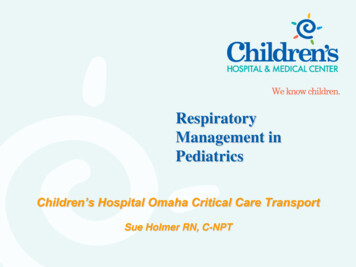

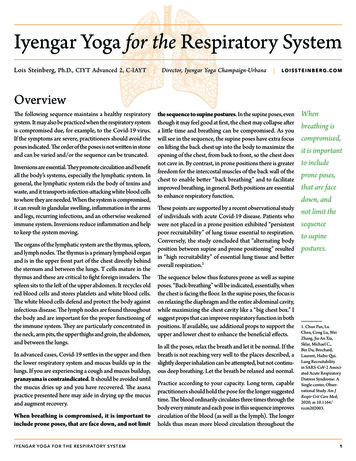

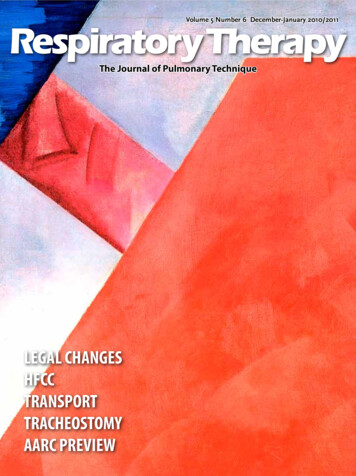
![Respiratory Therapy Training for Long-Term Care Nurses [Read-Only]](/img/29/handout-respiratory-20therapy-20training-20for-20long-term-20care-20nurses.jpg)
